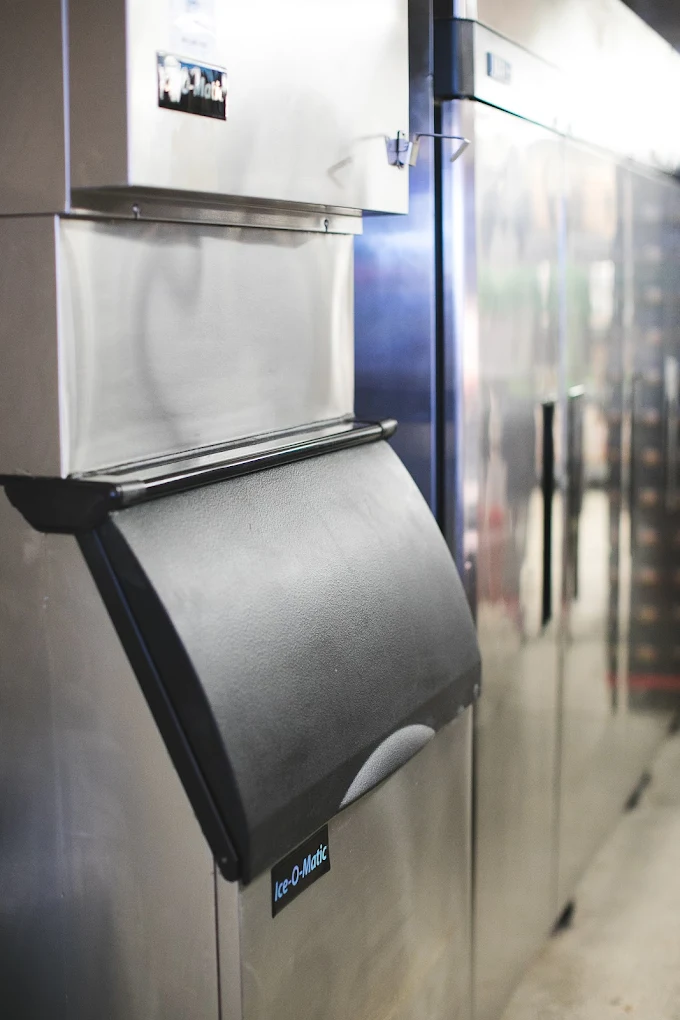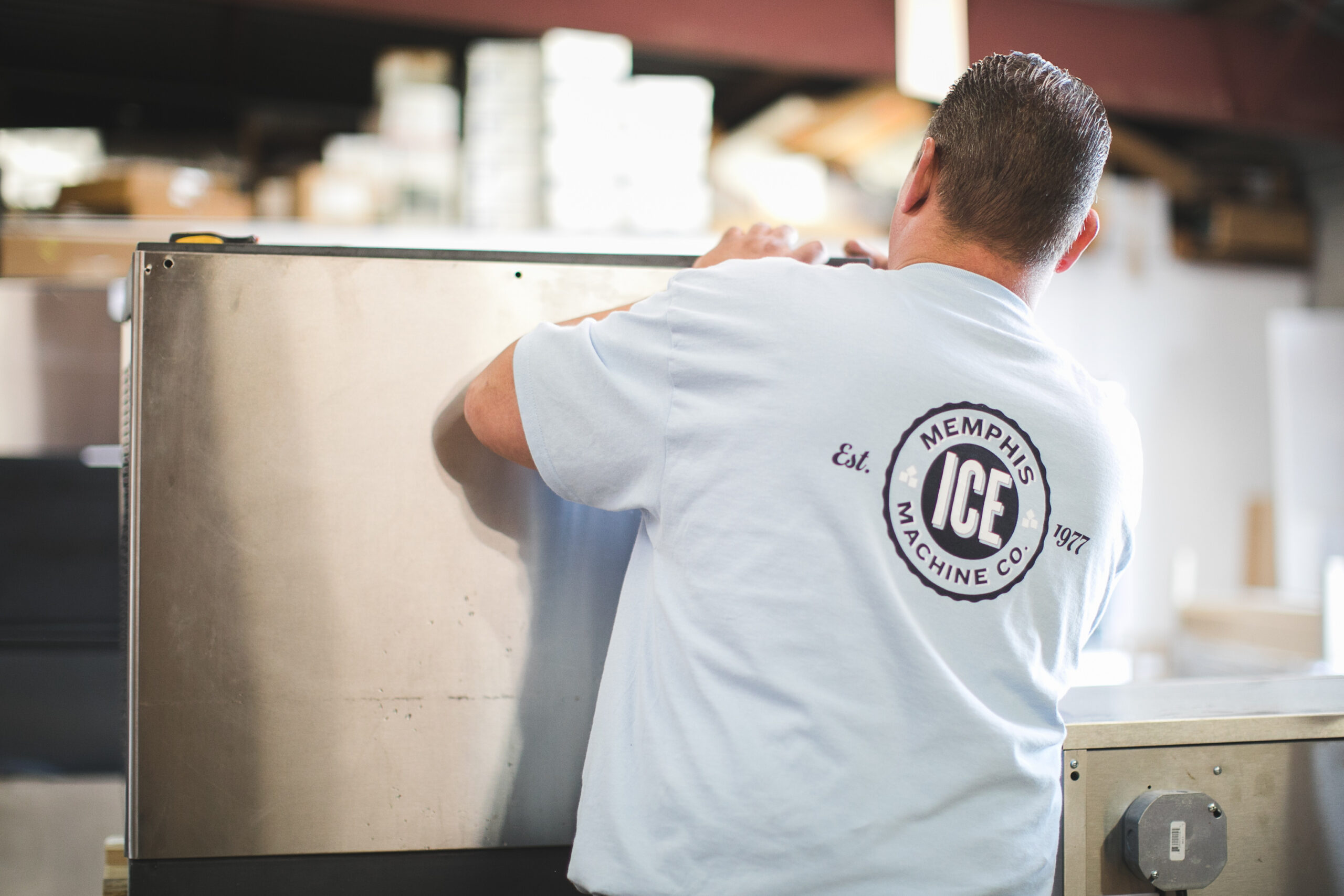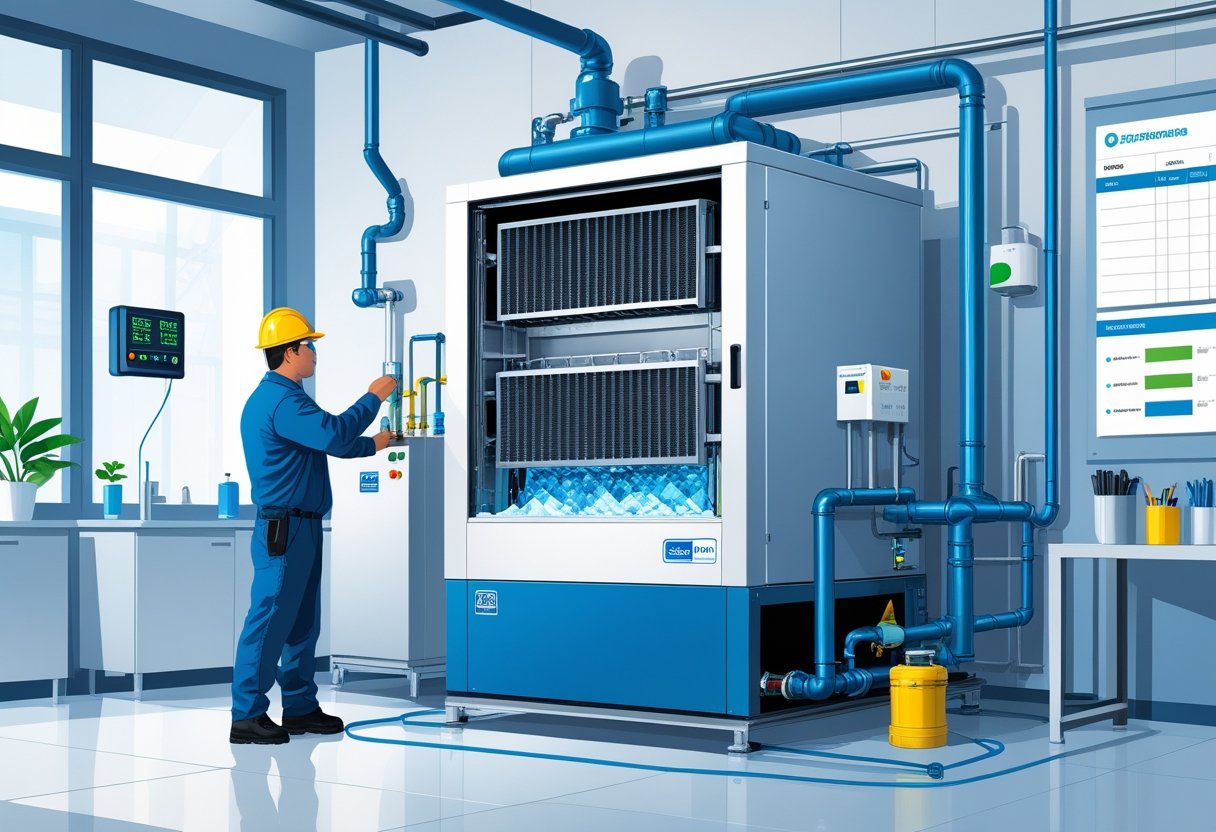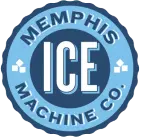proudly serving
the mid-south

How Often to Clean Your Restaurant Ice Machine for Optimal Hygiene and Efficiency
Keeping your restaurant’s ice machine clean is essential to maintaining food safety and ensuring your equipment runs smoothly. You should clean your commercial ice machine at least every three months, but in busy kitchens or hard-water areas, more frequent cleaning—sometimes monthly—is recommended to prevent bacteria and scale buildup. Neglecting this can lead to contamination risks and costly repairs.
Regular maintenance protects your investment and keeps ice quality high for your customers. At Memphis Ice, we’ve been helping local businesses maintain their ice machines since 1977, understanding how critical clean, reliable ice is to your daily operations. Whether you rent or own your equipment, establishing a cleaning schedule will save you headaches down the road.
By sticking to a routine cleaning plan, you reduce health risks and comply with regulations, giving you peace of mind. For tailored advice on ice machine maintenance in the Mid-South, trust Memphis Ice’s experienced technicians to guide you through the best practices for your specific setup.
How Often to Clean Your Restaurant Ice Machine
Keeping your commercial ice machine clean is critical for maintaining ice quality, avoiding health code violations, and preventing bacterial contamination. Regular cleaning schedules and awareness of warning signs help protect your business and customers.
Recommended Cleaning Frequencies
For most restaurant environments, cleaning your ice machine at least four times per year is advisable. The FDA recommends a minimum of two cleanings annually, but quarterly maintenance is better for safety and performance.
Daily surface cleaning, such as wiping down dispensers and removing debris, helps maintain hygiene between deep cleanings. Heavy use, poor water quality, or a humid environment may require more frequent cleanings.
Scheduling routine maintenance with a trusted provider like Memphis Ice ensures your machine stays sanitized and operational. Proper upkeep extends equipment lifespan and supports food safety standards.
Warning Signs Your Ice Machine Needs Cleaning
If you notice your ice cubes are cloudy, smaller, or oddly shaped, it’s a signal your machine may need cleaning. Reduced ice production or a strange odor are also red flags.
Buildup of mineral deposits or mold can cause visible residue inside the ice maker. This buildup is a hygiene risk and can lead to health code violations during inspections.
Ignoring these signs can escalate bacterial contamination. Promptly addressing issues reduces downtime and prevents costly repairs or reputational damage.
Health Risks of Infrequent Cleaning
An unclean ice machine can harbor bacteria such as Listeria and E. coli, putting your patrons at risk of illness. Ice is classified as a food item, so contamination affects food safety directly.
Neglecting cleaning schedules increases the chance of mold growth, which affects both ice quality and machine longevity. This compromises your compliance with health regulations.
Bacterial contamination can lead to health code violations that jeopardize your business license. Regular cleaning controls these risks, protecting customers and your reputation. For reliable service in the Mid-South, Memphis Ice provides stress-free maintenance plans tailored to your needs.
Key Factors That Determine Cleaning Frequency
Knowing how often to clean your commercial ice machine depends on several practical factors. These include the quality of your water supply, how heavily your machine is used, and the environment around your equipment. Each of these influences buildup, contamination risk, and overall machine health.
Impact of Water Quality and Water Filters
Water quality directly affects how often you must clean your ice machine. Hard water, rich in minerals like calcium and magnesium, leads to scale buildup inside your system. This buildup compromises ice quality and forces more frequent deep cleanings to maintain performance and health code compliance.
Installing and maintaining proper water filters helps reduce sediment and mineral deposits. A well-maintained filtration system can extend the intervals between cleanings by preventing scale and contaminants from accumulating. However, filters need regular inspection and replacement based on usage and water tests.
If your water supply contains high levels of bacteria or organic matter, these can foster mold and slime formation inside the machine. That heightens the urgency of cleaning to protect ice safety. Monitoring your water quality and filter condition is essential for setting an effective cleaning schedule.
Machine Usage and Ice Production Volume
The amount of ice your machine produces daily determines wear and the frequency of cleaning needed. A commercial ice machine running continuously in a busy restaurant creates more moisture, heat, and potential residue than one used occasionally at a small office.
If your operation requires a constant ice supply, expect to clean the machine every 3 months or even monthly. Lower usage could allow for semi-annual or annual service. Consistent production also stresses parts, making routine maintenance crucial to avoid breakdowns.
High production volume means faster accumulation of scale, mold, or bacteria. Skipping timely cleaning risks impacting ice taste, quality, and machine lifespan. You should track your usage closely and plan maintenance accordingly to avoid these issues.
Environmental and Location Considerations
The environment where your ice machine operates plays a key role in how often it needs cleaning. A machine in a dusty kitchen or near cooking areas will collect more airborne grease and debris. This increases contamination risks and cleaning frequency.
Humidity and temperature also matter. Warm, moist environments encourage bacterial growth inside the ice machine, requiring more frequent disinfecting. Conversely, cooler, well-ventilated spaces slow these processes and reduce cleaning needs.
Additionally, if your machine shares water with other equipment or sits near high-traffic areas, cross-contamination potential rises. You should adapt your cleaning plan accordingly and inspect your environment regularly to keep ice safe and equipment running smoothly.
At Memphis Ice, we’ve seen how these factors influence cleaning routines across the Mid-South. Talk to an expert today to find the best schedule tailored for your location and usage.
Manufacturer and Industry Recommendations
Knowing the specific cleaning schedule advised by your ice machine’s manufacturer is critical for proper care. You also need to meet food safety regulations to avoid health risks and legal issues.
Manufacturer Guidelines
Your ice machine’s manufacturer typically sets the cleaning interval based on the model and usage conditions. Most recommend cleaning at least every 3 to 6 months. If your machine produces large volumes of ice or is in a location with poor water quality, more frequent cleaning may be necessary.
Follow the exact steps outlined in your machine’s manual. This usually involves applying a cleaning solution to the water trough and running a cleaning cycle, which can last between 15 and 30 minutes. Ignoring these guidelines can reduce efficiency, cause buildup, and shorten equipment life.
Consult your manufacturer’s instructions regularly and keep records of cleaning. These efforts help prevent equipment failure and align with food safety expectations.
Compliance with Food Safety Regulations
Food safety agencies, including the FDA, require that commercial ice machines be cleaned at least twice a year, with many experts recommending quarterly cleanings to maintain hygiene. Failure to comply can lead to health code violations and contamination risks from bacteria or mold.
Your ice machine must stay free of biofilm and mineral deposits that compromise ice quality. Regular professional service or a trusted local partner like Memphis Ice can assist you in meeting these benchmarks while reducing your workload.
Maintaining cleaning schedules reduces the risk of service interruptions and supports a clean, safe environment for your customers and staff.
Structured Ice Machine Cleaning Schedules
Keeping your commercial ice machine in peak condition relies on a clear, consistent cleaning routine. This involves specific daily tasks to prevent buildup, regular weekly and monthly maintenance to maintain efficiency, and deep cleanings that address harder-to-reach or neglected areas. Following a structured schedule safeguards ice quality and extends your machine’s lifespan.
Daily Cleaning Tasks
Daily cleaning focuses on removing surface contaminants and ensuring the ice is hygienic. Start by wiping down the exterior surfaces and door handles with a food-safe sanitizer. Clean the ice bin to prevent mold and bacterial growth, as this area is prone to moisture buildup.
Empty any remaining ice at the end of the day to avoid stale ice. Check and clean the water inlet screen to ensure proper flow and prevent clogging. This helps avoid scale formation from minerals and protects the machine’s internal components.
You should also inspect the condenser coils for dust or debris daily, especially during warmer months, to maintain cooling efficiency. Dusty coils force the compressor to work harder, shortening equipment life.
Weekly and Monthly Maintenance
Your weekly routine should include a more thorough cleaning of the ice bin with warm water and a mild detergent. Sanitizing the bin after washing is important to eliminate any remaining bacteria. Inspect water filters every week and replace them monthly or as needed based on usage and water quality.
Monthly maintenance extends to checking the machine’s drain lines for blockages and cleaning them to prevent mold or slime buildup. Examine the ice machine’s door gasket for wear or damage to ensure a proper seal, preventing air contamination.
Descaling is a critical monthly task, especially if you operate in a hard-water area. Removing mineral deposits inside the machine maintains water flow and ice quality, cutting down on costly repairs later. Proper descaling prevents damage to internal parts.
Quarterly and Bi-Annual Deep Cleaning
Deep cleaning every three to six months involves a full disassembly of accessible components, sanitizing the ice maker’s evaporator plate, and a thorough internal inspection. This includes cleaning the water reservoir, spray nozzles, and any tubing that can harbor bacteria or scale.
Quarterly cleanings should involve applying a manufacturer-recommended sanitizing solution and carefully rinsing all parts to avoid chemical residue. Pay close attention to areas behind panels and around refrigeration components, which can accumulate debris unnoticed.
Bi-annual service may require professional support, especially for condenser coil cleaning, refrigerant checks, and verifying operational settings. These steps ensure your ice machine runs reliably year-round, especially through Memphis’ summer surge. Scheduling this service with Memphis Ice helps you stay on track with maintenance and avoid unexpected downtime.
Best Practices for Maintaining Ice Machine Cleanliness
Maintaining your ice machine isn’t just about keeping it visually clean; it requires a focused approach to stop scale buildup and bacterial contamination. These two factors directly affect ice quality, machine efficiency, and hygiene compliance. Regular care and attention to specific areas will help your equipment run smoothly and produce safe ice consistently.
Preventing Scale and Bacterial Contamination
Scale buildup from minerals in water can clog your machine and harm its performance. To prevent this, clean your machine at least every three months, or more often in hard-water areas. Use a manufacturer-approved descaler to break down mineral deposits, and make sure to rinse thoroughly afterward.
Bacterial contamination grows quickly in damp, warm conditions inside the machine. Regular cleaning and sanitizing remove organic material and biofilm where bacteria thrive. Scrub all accessible surfaces, especially the water reservoir and ice storage bin. Consider implementing daily wipe-downs of the exterior and weekly checks to spot any visible residue.
Using clean water and maintaining proper machine temperature helps limit bacteria growth. Follow a sanitation schedule recommended by experts, like the one provided in this expert cleaning guide.
Prolonging Ice Machine Lifespan
Your ice machine is a significant investment. Keeping it in top shape adds years to its service life, reducing costly repairs or premature replacement. Stick to a routine cleaning schedule that includes descaling, sanitizing, and checking internal components.
Replace worn or damaged parts promptly to avoid strain on the system. Pay special attention to filters, water lines, and drainage systems, since these areas often cause machine failures if neglected.
At Memphis Ice, we recommend regular professional maintenance to complement your cleaning. This approach maximizes reliability and keeps your restaurant’s ice production uninterrupted. Consider a maintenance plan that fits your usage and local water quality, ensuring your ice stays clean and your machine lasts longer. Learn more about effective maintenance strategies at Smart Care’s commercial ice machine cleaning tips.
Frequently Asked Questions
Keeping your ice machine clean protects your customers and helps your equipment last longer. Proper care depends on factors like water quality, usage, and machine type, with recommended schedules varying accordingly.
What is the recommended frequency for cleaning a commercial ice machine?
Most manufacturers and food safety experts suggest cleaning your commercial ice machine at least every 3 to 4 months. If you operate in a hard water area or have heavy usage, cleaning every 1 to 2 months might be necessary.
What are the health department guidelines for sanitizing ice machines in restaurants?
Health departments usually require that ice machines be cleaned and sanitized at least quarterly to prevent contamination. Following manufacturer instructions and local regulations ensures your ice meets food safety standards.
What steps are involved in properly cleaning a countertop ice maker?
Start by unplugging the machine and removing all ice. Use a cleaning solution recommended by the manufacturer to scrub interior surfaces, focusing on trays and crevices with a brush. Rinse thoroughly and sanitize before restarting.
What is the suggested cleaning schedule for a portable ice maker?
Portable ice makers need cleaning more frequently due to their smaller size and exposure. Cleaning should occur every 2 to 3 weeks or monthly, especially if you notice ice with odd tastes or buildup.
How often should ice machines be cleaned in a pub or bar setting?
Bars often clean their ice machines more regularly—at least quarterly, with some opting for monthly cleanings—to avoid mold, slime, and off-flavors that can affect drink quality.
What are the FDA regulations concerning the maintenance and cleaning of ice machines?
FDA food safety laws require that ice be handled and stored like food, which means ice machines must be cleaned and sanitized following manufacturer guidelines. Generally, this means cleaning at least 2 to 4 times a year.
For reliable cleaning and maintenance service in the Mid-South, Memphis Ice can help keep your equipment in top shape. We’ve been keeping businesses cool since 1977 and know how to minimize your downtime.
Recent News

Before the Feast: Ice Machine Maintenance Tips for a Smooth Holiday Season

Small Business Saturday! Keep It Local, Keep It Cool

Cold Weather, Cool Drinks! Why Ice Still Matters in Fall and Winter

How to Prep Refrigeration Equipment for Summer to Ensure Peak Efficiency and Longevity

How to Improve Ice Machine Efficiency for Optimal Performance and Energy Savings

How to Choose the Right Commercial Ice Machine for Your Business Needs



